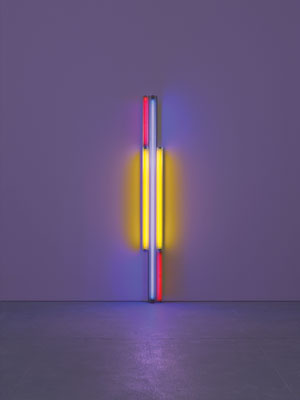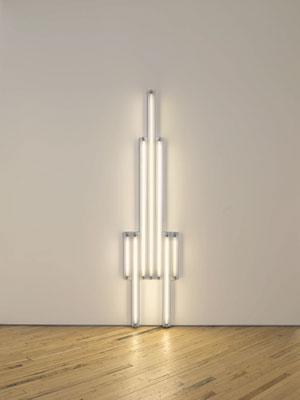Looking west from downtown Fort Worth, you might have recently noticed an intriguing green glow on the horizon.

Dan Flavin... untitled (to the real Dan Hill) 1b... 1978... blue, green, yellow, and pink fluorescent light... 8 ft. (244 cm) high, leaning
Like a moth mesmerized by the radiance, you might even have zeroed in on the light’s source, finding the green beacon to emanate from a series of Dan Flavin’s fluorescent lights (untitled (to you, Heiner, with admiration and affection), 1973), situated within a window bay of the Modern Art Museum of Fort Worth. The museum’s current installation, Dan Flavin: A Retrospective, will lure you in further with Flavin’s hypnotic brilliance.
Like the ghostly green aura lingering around the Modern, a tinge of irony is sure to haunt any review of Flavin’s art. During his lifetime (he died in 1996), Flavin remained obstinately opposed to critical art writing, declaring, “I know of no occupation in American life so meaningless and unproductive as that of the art critic.”[1] Critical analyses of his work could elicit scathing remonstrances from him. Distrusting the written word, he developed his own vocabulary to describe his art: he referred to his works as "proposals," which were "situational" (not sculptural), within an "exposition" (not exhibition). He denied the labels of Minimalist and sculptor, even though he commanded an influential role within the advent of Minimalist sculpture (he exhibited alongside Donald Judd, Sol Le Witt, and Carl Andre). In order to further control the language surrounding his art, Flavin often composed his own essays — which, though they had the authority of the artist’s voice, were often less than articulate. He acknowledged this later in his life, responding to the question of why he stopped writing by confessing, “I guess I felt I wasn’t coming across adequately.”[2] Even his own words failed to faithfully represent the profoundly experience-based quality of his art.
Flavin rigorously scrutinized not only the language describing his art, but also his gallery presentations, which are some of the earliest examples of installation art. His lights demand immaculate walls to act as pristine canvases, showing off the subtle undulations and precise corners of his colored reflections. As with most Minimalists, for Flavin’s work the gallery becomes a secularized sanctuary, where space maintenance is attended to with religious fervor. In all aspects of presenting Dan Flavin: A Retrospective, the Modern exhibits meticulous calculation and eliminates every possible visual distraction. The purity of architect Tadao Ando’s construction materials and the order of his building’s proportions complement this exposition extraordinarily well. Flavin’s fluorescence volumizes the museum building, his bars of light resonating with similar crisp lines of the architecture. The only disturbance is Ando’s otherwise welcome windows, which let in an abundance of natural light. In a few areas of this installation, the sunlight intrudes and waters down what would otherwise be Flavin’s saturated fluorescence.

Dan Flavin... untitled (to Piet Mondrian)... 1985... red, yellow, and blue fluorescent light; 8 ft. (244 cm) high
This exhibition supplements two permanent Texas installations of Flavin’s work, at Chinati Foundation in Marfa, and The Menil Collection in Houston. Organized by the Dia Foundation along with the National Gallery of Art, this show marks the first retrospective of Flavin’s work in over 30 years. Not only does it encompass Flavin’s earliest forays into fluorescent potential, it also surveys his works on paper, providing an encyclopedic viewing of his life’s work, which ranges from his early abstract expressionist painting to his mature light constructions. The bulk of the exhibition tracks Flavin’s explorations of standardized light fixtures (two, four, six, and eight feet-long tubes and one foot-diameter circular tubes) and the fluorescent spectrum (blue, red, green, pink, yellow, ultraviolet, and four varieties of white).
Flavin’s light constructions are at times deceptively simple. He affirmed this sensibility by declaring of his work, "it is what it is and it ain’t nothing else."[3] Given his druthers, there wouldn’t even be benches in the exhibition because, in his estimation, his works are not complicated enough to merit extended contemplation. Despite the artist’s own prescription for a quickened viewing tempo, the proposals are captivatingly complex. With only a basic armory of industrialized light fixtures, Flavin arranged common objects in such a way as to create painterly effects of intensified light and color. In doing so, he destabilized traditional boundaries between sculpture and painting. His proposals hover between three-dimensionality and two-dimensionality, between the mundane and the sublime.
Although Flavin embraced the industrial quality of mass-produced fluorescent light fixtures, his proposals are vitalized by a human element. Unlike a typical exhibition where gallery lighting casts an illuminating halo on individual artworks, Flavin’s exposition directs the light outward to the viewer, who becomes the center of the experience. As you move through the individual galleries permeated with light, you seemingly wade through fluorescent hues. Flavin fortifies this human relationship in the titling of his works, many of which include dedications to specific individuals. One of the most provocative is greens crossing greens (to Piet Mondrian who lacked green), 1966. Two fences of post-and-lintel modular units intersect in a giant X, bathing a six-sided room in vivid green light. Even the light strips in the ceiling are accentuated with this emerald hue, as Flavin himself often dictated, activating the architecture of the exhibition space. By dedicating the proposal to Mondrian, Flavin demonstrates the possibilities of two formal elements that the elder Minimalist avoided and disdained: green and diagonals. This ironic homage is not a complete affront — Flavin merely translated his predecessor’s restricted pigment palette into fluorescence, in which green replaces yellow as a central color.

Dan Flavin... "monument" 1 for V. Tatlin... 1964... 8 ft. (244 cm) high; cool white fluorescent light
Throughout this retrospective, Flavin’s installations heighten visual sensitivity. Staring long enough at a concentration of green lights (as in the green wall of the corridor installation untitled (to Jan and Ron Greenberg)) will cause an ocular whiteout, as the light’s intensity tattoos your retinas with the bulbs’ afterimage. Afterward, other hues look skewed: truly white lights appear pink. With Flavin afterimages seared into your eyeballs, the Modern’s permanent collection looks surprisingly sterile by comparison. While other artists allude to light and color, Flavin more successfully captures the essential intensity of these compositional elements.
Flavin’s art departs from the traditional fields of painting and sculpture in issues of conservation as well. With only a 2100-hour life, the bulbs require periodic replacing. He embraced this ephemeral aspect of his art, enthusing, about his wholehearted belief in temporary art.[4] When you buy a Flavin, you buy not simply the light fixture, but more importantly the idea for a specific proposal and an authenticating certificate signed by the artist. Flavin reinforced the impermanence of his work by having some of the certificates printed on cheap pulp paper, thereby ensuring their eventual disintegration, analogous to the bulbs’ eventual burning out.
In this retrospective, the Modern virtually hums with the intensity of Flavin’s light proposals. As baiting as the green beacon on the horizon may be, though, don’t succumb to any moth-like behavior unprepared. Otherwise, you may experience some burning side effects, including headaches and blurred vision. Viewers with light-sensitive eyes may want to take the museum guards’ lead and come equipped with sunglasses. Whether seen with or without protective eyewear, Flavin’s exposition transforms a banal object — the fluorescent light fixture — into the basis for a stimulating aesthetic experience.
1. Dan Flavin, “some remarks…excerpts from a spleenish journal,” Artforum 5, no. 4 (December 1966), p. 28. [return to article]
Images courtesy of the Modern Art Museum of Fort Worth.
Catherine Deitchman is a writer living in Dallas.



